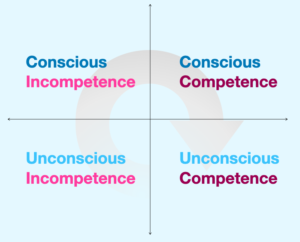A common challenge for the design leaders I support is identifying metrics. They know their team is having a positive impact, but struggle articulating it in any concrete way. They seek canonical, industry-standard metrics that prove UX/Design’s value, but the reality is, no such metrics exist. The nature of UX/Design’s impact is specific to the company, the audience, and the problem space under question.
I have found that, to have productive metrics discussions, it’s crucial to appreciate organizational maturity. For example, it’s hard to have a meaningful discussion of how UX/Design effects business outcomes if the company doesn’t have a model of Customer Lifetime Value (CLTV) that maps customer behaviors and actions to a probability of financial return.
And when I think of maturity, I find myself returning to the four stages of competency model (shown below), which can be used as a generic maturity model in a wide array of contexts.

At the initial stage of Unconscious Incompetence, the organization is deeply immature, not knowing what it doesn’t know. No one I work with is at this level, because working with me presupposes some kind of ‘conscious’ness.
The design leaders I work with seek to establish Conscious Competence, usually in the form of robust UX metrics that connect to impact, but often find themselves in Incompetent organizations that aren’t ready to make those connections.
In fact, in a Conscious Incompetent organization, UX metrics may be seen as self-interested or vain, that the UX/Design team going off doing their thing, potentially eroding trust with colleagues.
Instead, you need to meet the organization where it’s at, which might mean ‘dumbing down’ how you gauge success. In a Design-immature organization, where you’re just trying to get a footing, the opinion your more established partners (e.g., product management, engineering) have of you may be how you show your worth.
Or, it’s likely that your organization has some rudimentary understanding of experience (e.g., anecdotes from customer care; NPS), and so you begin there, taking the language that already exists, demonstrating your concern for those areas. Over time, as you build credibility, you will then be able to introduce more mature UX/Design metrics that you know are better indicators of value.
But proving the UX/Design organization’s value, even if sophisticated, is a sign that you have not yet reached full maturity.
The 4 Stages model shows that at the highest level of maturity, the UX/Design organization no longer needs metrics that prove its worth. It’s simply understood (“unconsciously”) throughout the company that UX/Design is worth doing. This was highlighted for me in the Finding Our Way conversation with Daniela Jorge, Chief Design Officer at PayPal, when she shared, “We don’t have hard metrics that I own from an experience standpoint, but we define those per project, right? So if we have a specific project that’s around helping customers achieve a specific goal, those are defined at the initiative level.” At PayPal, they recognize that its ultimately foolish to assign impact metrics to a function, because impact is realized through cross-functional work.
But for the Design team to get there, I’m guessing (we didn’t ask), that they did have to go through these stages of proving their worth, enabling the executive leadership team’s unconscious confidence in design’s value.